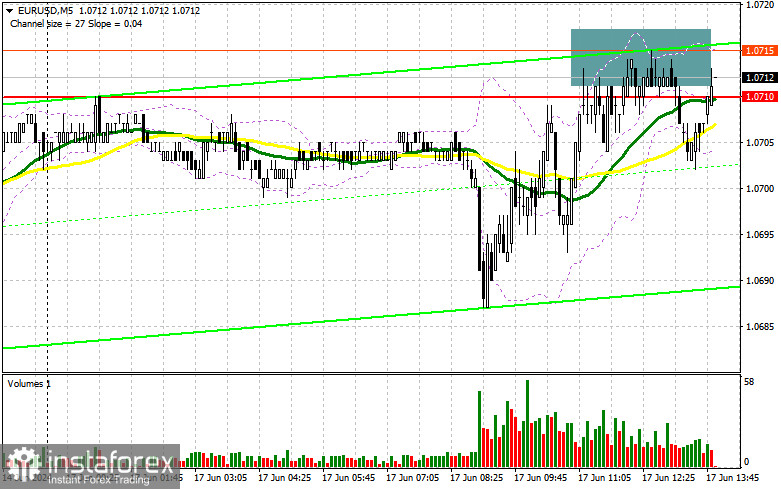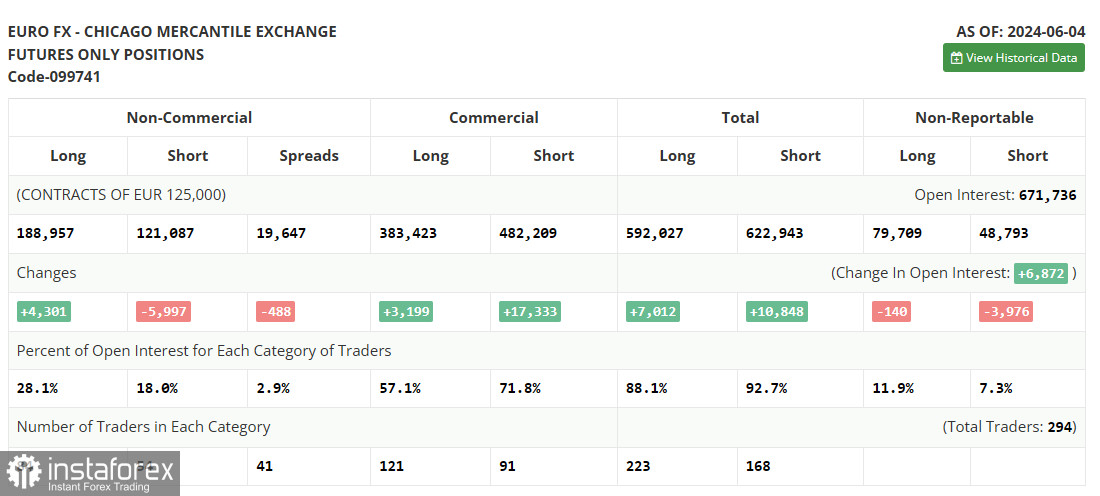I highlighted the 1.0710 level in my morning forecast and planned to make entry decisions based on it. Let's look at the 5-minute chart and see what happened there. The rise and formation of a false breakout at that level gave a signal to sell the euro further along the trend. However, as you can see from the chart, a proper downward movement had yet to materialize by the time the forecast was written. The technical picture was not revised for the second half of the day.

To Open Long Positions on EUR/USD:
Buyers quickly become active due to the absence of statistics and the strong bearish market. Problems around the 1.0710 level demonstrate this. Unfortunately, there are also no sellers who drove the market down on Friday. Let's see what the Empire Manufacturing Index in the US shows in the second half of the day and listen to what FOMC members John Williams and Patrick T. Harker say. A hawkish stance from the policymakers will surely bring pressure back on the euro, which I plan to capitalize on. A drop and the formation of a false breakout around 1.0675 will be a suitable entry point for long positions with the aim of another test of 1.0710 – a resistance level that has not yet been breached. Breaking and settling above this range will strengthen the pair with a chance of rising to the 1.0743 area. The farthest target will be the 1.0783 maximum, where I will take profits. Testing this level will return the balance to the market. In the scenario of EUR/USD falling and no activity around 1.0675 in the second half of the day, pressure on the pair will significantly increase, leading to a new drop. In this case, I will enter only after a false breakout around the next support at 1.0642. I plan to open long positions immediately on a rebound from 1.0601 with the goal of an upward correction of 30-35 points within the day.
To Open Short Positions on EUR/USD:
Sellers have made their presence felt, but significant drops have yet to occur, which may lead to a larger upward correction, so be cautious when making new decisions. Only another false breakout at 1.0710, similar to what I analyzed above, will be an appropriate entry point for short positions to further fall to the support at 1.0675. Breaking and settling below this range and a retest from the bottom up will provide another selling point with a movement towards the new low of 1.0642, where I expect more active bullish engagement. The farthest target will be the 1.0601 minimum, where I will take profits. In the case of an upward movement in EUR/USD in the second half of the day and no bears at 1.0710, buyers will manage to recover some of the losses incurred last Friday. I will postpone sales until testing the next resistance at 1.0743 in this scenario. There, I will also sell, but only after an unsuccessful consolidation. I plan to open short positions immediately on a rebound from 1.0783 with the goal of a downward correction of 30-35 points.


Indicator Signals:
Moving Averages:
Trading is conducted around the 30 and 50-day moving averages, indicating a sideways market nature.
Note: The author considers the period and prices of moving averages on the hourly chart H1 and differs from the general definition of classical daily moving averages on the daily chart D1.
Bollinger Bands:
In case of a decline, the lower boundary of the indicator, around 1.0700, will act as support.
Indicator Descriptions
- Moving Average (MA): Determines the current trend by smoothing volatility and noise. Period 50. Marked in yellow on the chart.
- Moving Average (MA): Determines the current trend by smoothing volatility and noise. Period 30. Marked in green on the chart.
- MACD Indicator (Moving Average Convergence/Divergence): Fast EMA period 12, Slow EMA period 26, SMA period 9.
- Bollinger Bands: Period 20.
- Non-commercial Traders: Speculators such as individual traders, hedge funds, and large institutions that use the futures market for speculative purposes and meet certain criteria.
- Long Non-commercial Positions: Represent the total long open position of non-commercial traders.
- Short Non-commercial Positions: Represent the total short open position of non-commercial traders.
- Total Non-commercial Net Position: The difference between short and long positions of non-commercial traders.
 English
English 
 Русский
Русский Bahasa Indonesia
Bahasa Indonesia Bahasa Malay
Bahasa Malay ไทย
ไทย Español
Español Deutsch
Deutsch Български
Български Français
Français Tiếng Việt
Tiếng Việt 中文
中文 বাংলা
বাংলা हिन्दी
हिन्दी Čeština
Čeština Українська
Українська Română
Română

